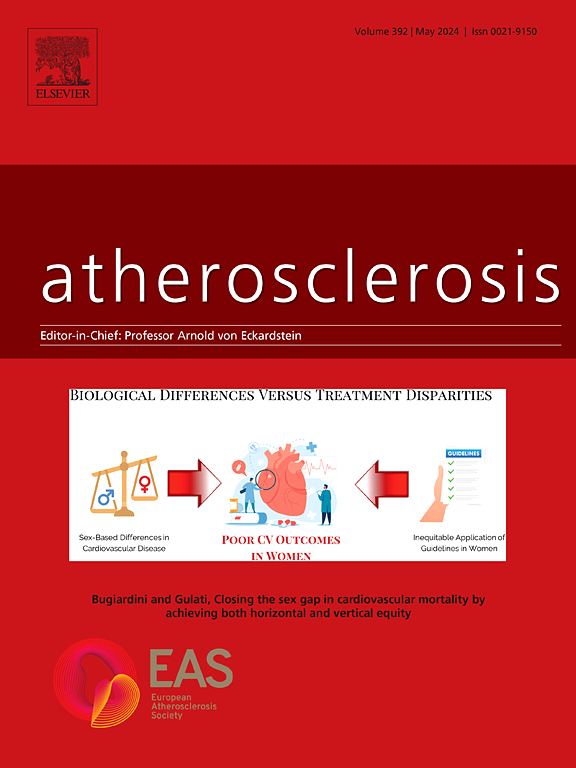Iron biomarkers predict peripheral artery disease in females
IF 4.9
2区 医学
Q1 CARDIAC & CARDIOVASCULAR SYSTEMS
引用次数: 0
Abstract
Background and aim
Iron overload has been proposed as a risk factor for atherosclerosis, but the available data are controversial. Here, we investigated whether iron status shows sex-specific associations with peripheral arterial disease (PAD).
Methods
Using two different analytical approaches (machine-learning and logistic regression), we studied the association between blood iron biomarkers and PAD in 368 individuals from the Heidelberg Study on Diabetes and Complications (HEIST-DiC) and in 5101 individuals from the National Health and Nutrition Examination Survey (NHANES 1999–2004). Additionally, by analysing data from the UK Biobank, we investigated the odds of PAD in individuals with hemochromatosis genotypes (n = 448,575).
Results
We found that iron biomarkers were among the top predictors of PAD in the machine-learning classification in both cohorts. In the HEIST-DiC cohort, ferritin, iron, and transferrin were ranked among the top predictive markers, while in the NHANES cohort, ferritin, total iron binding capacity (TIBC), transferrin saturation (TSAT) and iron showed high predictive power. In the regression analysis, ferritin showed a positive interaction among females in the HEIST-DiC (OR 2.68, 95% CI 0.94–7.61, P = 0.057) and NHANES cohorts (OR 1.76, 95% CI 1.16–2.67, P = 0.008). The multivariable regression analysis of the NHANES cohort detected a nonlinear relationship between ferritin and PAD, in that, certain ferritin ranges (48–97 ng/mL: OR 14.59, 95% CI 1.6–135.93, P = 0.019; 98–169 ng/mL: OR 171.07, 95% CI 1.27–23404, P = 0.039) in females were positively associated with PAD. Nevertheless, we did not detect significant associations between hemochromatosis genotypes and PAD in the UK Biobank.
Conclusion
Taken together, our data show that iron biomarkers, importantly, elevated ferritin within physiological limits are associated with clinically apparent PAD in females. These findings add to the body of evidence suggesting sex differences in PAD and highlight a possible role of iron (directly or indirectly) in this relationship.

铁生物标志物预测女性外周动脉疾病
背景和aimIron超载被认为是动脉粥样硬化的危险因素,但现有数据存在争议。在这里,我们研究了铁状态是否与外周动脉疾病(PAD)存在性别特异性关联。方法使用两种不同的分析方法(机器学习和逻辑回归),我们研究了来自海德堡糖尿病及并发症研究(HEIST-DiC)的368名个体和来自国家健康与营养调查(NHANES 1999-2004)的5101名个体的血铁生物标志物与PAD之间的关系。此外,通过分析来自UK Biobank的数据,我们调查了血色素沉着症基因型个体(n = 448,575)患PAD的几率。结果我们发现,铁生物标志物是两个队列中机器学习分类中PAD的主要预测因子之一。在HEIST-DiC队列中,铁蛋白、铁和转铁蛋白是最重要的预测指标,而在NHANES队列中,铁蛋白、总铁结合能力(TIBC)、转铁蛋白饱和度(TSAT)和铁具有较高的预测能力。在回归分析中,铁蛋白在HEIST-DiC组(OR为2.68,95% CI为0.94-7.61,P = 0.057)和NHANES组(OR为1.76,95% CI为1.16-2.67,P = 0.008)的女性中显示出正相互作用。NHANES队列的多变量回归分析发现铁蛋白与PAD存在非线性关系,铁蛋白在一定范围内(48 ~ 97 ng/mL: OR 14.59, 95% CI 1.6 ~ 135.93, P = 0.019;98 ~ 169 ng/mL: OR 171.07, 95% CI 1.27 ~ 23404, P = 0.039)与PAD呈正相关。然而,在UK Biobank中,我们没有发现血色素沉着病基因型和PAD之间的显著关联。综上所述,我们的数据显示铁生物标志物,重要的是,生理范围内铁蛋白升高与女性临床明显的PAD有关。这些发现进一步证明了PAD的性别差异,并强调了铁(直接或间接)在这一关系中的可能作用。
本文章由计算机程序翻译,如有差异,请以英文原文为准。
求助全文
约1分钟内获得全文
求助全文
来源期刊

Atherosclerosis
医学-外周血管病
CiteScore
9.80
自引率
3.80%
发文量
1269
审稿时长
36 days
期刊介绍:
Atherosclerosis has an open access mirror journal Atherosclerosis: X, sharing the same aims and scope, editorial team, submission system and rigorous peer review.
Atherosclerosis brings together, from all sources, papers concerned with investigation on atherosclerosis, its risk factors and clinical manifestations. Atherosclerosis covers basic and translational, clinical and population research approaches to arterial and vascular biology and disease, as well as their risk factors including: disturbances of lipid and lipoprotein metabolism, diabetes and hypertension, thrombosis, and inflammation. The Editors are interested in original or review papers dealing with the pathogenesis, environmental, genetic and epigenetic basis, diagnosis or treatment of atherosclerosis and related diseases as well as their risk factors.
 求助内容:
求助内容: 应助结果提醒方式:
应助结果提醒方式:


